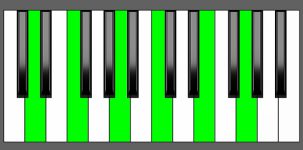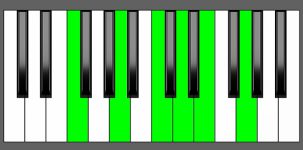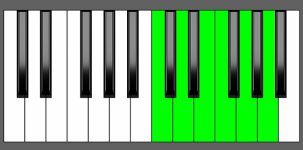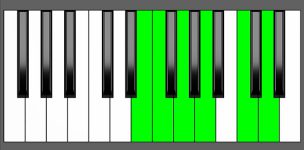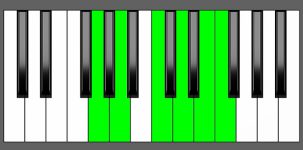Piano Diagram of Dm11 in Root Position
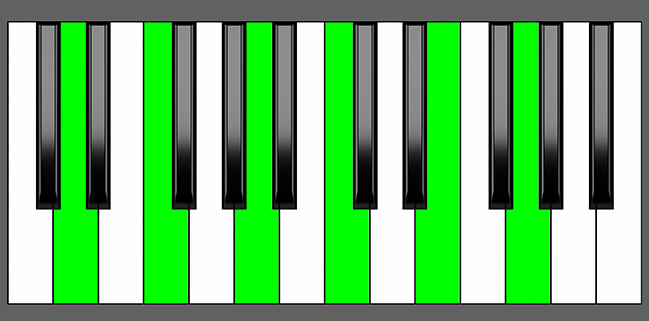
The Dm11 chord is a six-note chord that includes the root note (D), the minor third (F), the perfect fifth (A), the minor seventh (C), the major ninth (E), and the eleventh (G). This chord is commonly used as a variation or modulation for minor 7th chords. Keep reading to learn something more about this chord.
Structure of Dm11
Notes |
|---|
| D, F, A, C, E, G |
Intervals |
|---|
| R, m3, 5, m7, 9, 11 |
Playing Extended Chords on Piano
Extended chords are commonly used in piano playing, but they can be tricky to play in their entirety due to the large number of notes involved. To make these chords more manageable, pianists often omit certain notes, such as the root or the 5th. Another technique is to split the chord between both hands, playing either full or partial chords in each hand.
How to play a Dm11
For instance, in this scenario, you may opt to play a simplified version of Dm11 by omitting the 5th and 9th notes. This way, you will only need to play the root note D (which can be played using your left hand), the minor 3rd F, the minor 7th C, and the 11th note G with your right hand.
D + F, C, G
However, even when notes are omitted or split between hands, extended chords can still create complex and dense harmonies. When these chords are inverted, the resulting clusters of notes can be particularly challenging to voice effectively.
Dm11 Chord Inversions
The Dm11 chord has a total of 5 inversions:
| Root Position: | D | F | A | C | E | G |
| 1st Inversion: | F | A | C | D | E | G |
| 2nd Inversion: | A | C | D | E | F | G |
| 3rd Inversion: | C | D | E | F | G | A |
| 4th Inversion: | E | F | G | A | C | D |
| 5th Inversion | G | A | C | D | E | F |
Piano Keyboard Diagrams
Chord Inversion on Piano
Understanding chord inversions is an essential aspect of music theory as it helps to explain how chords are constructed and used in progressions. When playing chord inversions on a piano, it’s important to keep in mind that the diagrams used to illustrate the order of notes may not always be practical to play.
To achieve the proper chord voicings on a piano, you need to distribute the notes of the chord across various octaves and positions on the keyboard. This often means that the basic shape of the chord’s inversions shown in diagrams may not be the most convenient or comfortable way to play the chord.
While chord inversion diagrams can be useful in comprehending the structure and sequence of notes in a chord, it’s recommended to experiment with different voicings and fingerings to find the most efficient and comfortable way to play the chord while still preserving its intended harmonic function and sound.
Music Theory and Harmony of Dm11
The Dm11 chord is a diatonic extension of Dm7. While it can be substituted for the Dm7 chord in any position, it is commonly used in conjunction with it. Nonetheless, it’s worth noting that certain positions may not be as effective when substituting Dm11 for Dm7.
Building the Dm11 Chord: Different Approaches
Starting from the D Major Scale
To build a minor 11th chord, you would use the root note, the minor third, the fifth, the minor seventh, the major ninth, and the eleventh from a minor scale. However, for educational purposes, it may be clearer to demonstrate its construction using a major scale, as it better illustrates the relationship between intervals and their qualities.


To create a Dm11 chord, apply the formula R, m3, 5, m7, 9, 11 in the following manner:
- Begin with the Root note, which is D.
- Select the 3rd interval, which is F#, and then subtract a half-step to get the minor 3rd F.
- Add the 5th interval, which is A.
- Add the minor 7th interval, which is the 7th (C#) less a half-step, C.
- Add the major 9th which is E.
- Lastly, add the 11th G, which is a 4th interval at the higher octave.
By following this simple formula, you can create a minor 11th chord from any major scale.
by Combining Intervals
One method to create a minor 11th chord is by combining specific intervals – a minor 3rd, a major 3rd, a minor 3rd, a major 3rd and a minor 3rd. This is the formula:
m3 + 3 + m3 + 3 + m3 = minor 11th Chords
- To create a Dm11 chord, we start with the root note D and then add a minor 3rd interval, which is equivalent to moving up three half-steps from D, resulting in the note F.
- Following this, we include a major 3rd interval by moving three half-steps up from F, which leads to the note A.
- This pattern is continued by adding another minor 3rd interval, which brings the note C, followed by a major 3rd interval, leading to the note E.
- Lastly, we add the 11th note (G), which is found by moving up a minor 3rd from E, to complete the chord.
by Combining Chords
Another way to create minor 11th chords is to combine a minor triad with the major chord based on its minor 7th. For example, to build a Dm11 chord, you can mix a D minor triad (D, F, A) with a C Major chord (C, E, G).
D minor + C Major = Dm11
When played simultaneously, these two chords form a Dm11 chord (D, F, A, C, E, G).
How to Use Dm11 in a Chord Progression
The D minor 11th is an extension of the D minor 7th, with the addition of an extra 9th and an 11th note. This makes it a much fuller, more complex, and richer chord than Dm7.
In this post, we will focus on the most common uses of the Dm11 chord. The tables of the major and minor keys below include the D minor 7th chord, which can be substituted or complemented by a D minor 11th chord.
on Natural minor Scales
| Minor Scales | i | ii | III | iv | v | VI | VII |
|---|---|---|---|---|---|---|---|
| D | Dm7 ⇒ Dm11 | Em7b5 | F Maj7 | G min7 | A min7 | Bb Maj7 | C7 |
| A | A min7 | Bm7b5 | C Maj7 | Dm7 ⇒ Dm11 | E min7 | F Maj7 | G7 |
| G | G min7 | Am7b5 | Bb Maj7 | C min7 | Dm7 ⇒ Dm11 | Eb Maj7 | F7 |
- Tonic chord in D minor
- Subdominant chord in A minor
- Non-diatonic Dominant chord in G minor
on Major Scales
| Major Scales | I | ii | iii | IV | V | vi | vii |
|---|---|---|---|---|---|---|---|
| C | C Maj7 | Dm7 ⇒ Dm11 | E min7 | F Maj7 | G7 | A min7 | Bm7b5 |
| Bb | Bb Maj7 | C min7 | Dm7 ⇒ Dm11 | Eb Maj7 | F7 | G min7 | Am7b5 |
| F | F Maj7 | G mi7 | A min7 | Bb Maj7 | C7 | Dm7 ⇒ Dm11 | Em7b5 |
- Supertonic chord in C Major
- Non-diatonic Mediant chord in Bb Major
- Submediant chord in F Major
Non-diatonic positions in G minor and Bb Major
It’s important to note that the major ninth interval E clashes with the Eb note found in both the G minor and Bb major scales, as they are only a half step apart. As a result, it’s generally recommended to avoid using a minor 11th chord in this particular position. However, rather than outright avoiding it, I recommend evaluating the dissonance of the Dm11 chord in those positions and making a judgment based on your personal preferences.
Dm11 Function in Major and Minor Keys
Understanding Scale Degrees
Understanding scale degrees is essential for comprehending the relationship between the notes within chords and how they function. The diatonic major scale consists of seven degrees, each with a distinct role in shaping the overall harmony of the chords.
- The first degree of the scale is the Tonic, serving as the foundation for the chord progression. It establishes a stable tonal center, providing an anchor for the rest of the chords in the progression.
- The second degree is called the Supertonic, often used to create a sense of motion within the chord progression. It acts as a transitional chord between the Tonic and other chords in the progression.
- The third degree of the scale is the Mediant, sitting halfway between the Tonic and Dominant chords. It helps determine whether the chord progression is major or minor.
- The fourth degree is the Subdominant, complementing the Dominant and adding tension and resolution to the chord progression.
- The fifth degree is the Dominant, creating tension and anticipation within the chord progression, typically resolved by returning to the Tonic.
- The sixth degree is the Submediant, often employed as a transitional chord between the Dominant and Tonic, adding a sense of stability and restfulness to the chord progression.
- The seventh degree is the Leading tone, located one half-step below the Tonic. It creates a strong sense of tension and a desire to resolve to the Tonic, frequently used to create a sense of resolution and finality in the chord progression.
Dm11 as Tonic Chord in D minor
The D minor 11th chord is an interesting and distinct choice for the tonic chord in the D minor key. It creates a complex and ambiguous harmonic center due to the presence of the 11th interval (G), which adds tension and dissonance to the chord. This dissonance results in a sense of instability and uncertainty, which can be utilized to create a feeling of tension. However, it’s important to note that this dissonance can also make the chord challenging to use in certain musical contexts.
The Dm11 can be used to modulate between keys or to add harmonic color and contrast to a composition.
| i | ii | III | iv | v | VI | VII |
| D min7 | Em7b5 | F Maj7 | G min7 | A min7 | Bb Maj7 | C7 |
Dm11 Chord Progressions as i degree
The following chord progressions are examples of how the D minor 11th chord can serve as the tonic chord (i degree).
i VI VII III
| i | VI | VII | III |
| Dm11 | Dm7
D (C, F, G) | D (C, F, A) |
Bb Maj7 | C7 | F Maj7 |
To voice the Dm11 chord, you can consider playing the D root note with your left hand while using your right hand to play the notes C (minor 7th), F (minor 3rd), and G (11th). Likewise, for the Dm7 chord, you can play the D root note with your left hand and utilize your right hand to play the notes C, F, and A.
i iv VI VII
| i | iv | VI | VII |
| Dm11 | Dm7 | G min7 | Bb Maj7 | C7 |
I have a preference for resolving the D min11 chord to a more stable D chord, such as D minor or D minor 7th, within the same measure. However, I highly encourage you to explore various options and experiment with different chord progressions to discover what sounds best to you.
Circle Progression
| i | iv | VII | III | VI | ii | V7 | i |
| Dm11 | Dm7 | Gm7 | C7 | F Maj7 | Bb Maj7 | Em7b5 | A7 | D min7 |
Dm11 as Subdominant Chord in A minor
The D minor 11th can also be played as the subdominant chord in the key of A minor.
| i | ii | III | iv | v | VI | VII |
| A min7 | Bm7b5 | C Maj7 | D min7 | E min7 | F Maj7 | G7 |
Dm11 Chord Progressions as iv degree
The following chord progressions feature a Dm11 chord as the subdominant (iv degree):
iv III VI VII
| iv | III | VI | VII |
| Dm11 | Dm7 | C Maj7 | F Maj7 | G7 |
i iv VI v
| i | iv | VI | v |
| A min7 | Dm11 | Dm7 | F Maj7 | E min7 |
Circle Progression
| i | iv | VII | III | VI | ii | V7 | i |
| A min7 | Dm11 | Dm7 | G7 | C Maj7 | F Maj7 | Bm7b5 | E7 | A min7 |
Dm11 as Dominant Chord in G minor (Non-Diatonic)
The Dm11 chord can also serve as a variant of the dominant chord in the G minor scale. However, it’s worth noting that the interval of the 9th, which is the note E, may create dissonance when played alongside the Eb note found in the G minor scale, as they are only a half step apart.
| i | ii | III | iv | v | VI | VII |
| G min7 | Am7b5 | Bb Maj7 | C min7 | D min7 | Eb Maj7 | F7 |
Dm11 as v degree – Chord Progressions
To hear how the D minor 11th chord sounds as the dominant (V) chord in the G minor scale, you can try playing the following chord progressions. I recommend omitting the 9th, but you can still experiment with using it for a dissonant modulation or a particular effect.
i iv VI v
| i | iv | VI | v |
| G min7 | C min7 | Eb Maj7 | Dm11 | Dm7 |
i v VI VII
| i | v | VI | VII |
| G min7 | Dm11 | Dm7 | Eb Maj7 | F7 |
i VI v iv
| i | VI | v | iv |
| G min7 | Eb Maj7 | Dm11 | Dm7 | C min7 |
Dm11 as Supertonic Chord in C Major
In addition to its application in minor keys, the Dm11 chord can be employed in major keys as well. For example, in the key of C major, the Dm11 chord can function as the supertonic chord, found on the second degree of the scale.
| I | ii | iii | IV | V | vi | vii |
| C Maj7 | D min7 | E min7 | F Maj7 | G7 | A min7 | Bm7b5 |
Dm11 Chord Progressions as ii degree
Try playing the following chord progressions to better understand how the Dm11 chord functions as the supertonic (ii) chord in the key of C major.
ii V I
| ii | V | I |
| Dm11 | Dm7 | G7 | C Maj7 |
Circle Progression
| I | IV | vii | iii | vi | ii | V | I |
| C Maj7 | F Maj7 | Bm7b5 | E min7 | A min7 | Dm11 | Dm7 | G7 | C Maj7 |
Dm11 as Mediant Chord in Bb Major (Non-Diatonic)
In addition to its positions in minor keys and major keys, the Dm11 chord can also be played as the mediant (iii) chord in the key of Bb major, located on the third degree of the scale.
The 9th note (E) of Dm11 will eventually clash against the Eb present in the Bb major scale so be aware of the issue you could encounter using a non-diatonic chord.
| I | ii | iii | IV | V | vi | vii |
| Bb Maj7 | C min7 | D min7 | Eb Maj7 | F7 | G min7 | Am7b5 |
Dm11 Chord Progressions as iii degree
To better understand how the Dm11 serves as the mediant (iii) in the Bb major scale, you can try playing the following chord progressions:
I iii IV V
| I | iii | IV | V |
| Bb Maj7 | Dm11 | Dm7 | Eb Maj7 | F7 |
I iii ii V
| I | iii | ii | V |
| Bb Maj7 | Dm11 | Dm7 | C min7 | F7 |
I iii vi V
| I | iii | vi | IV |
| Bb Maj7 | Dm11 | Dm7 | G min7 | Eb Maj7 |
Dm11 as Submediant Chord in F Major
The Dm11 chord can be played on the sixth degree of the F major scale, as a variation of the submediant chord.
| I | ii | iii | IV | V | vi | vii |
| F Maj7 | G min7 | A min7 | Bb Maj7 | C7 | D min7 | Em7b5 |
Dm11 as vi degree – Chord Progressions
You can explore the sound of Dm11 as the submediant chord in the key of F major by playing the following chord progressions:
I iii vi V
| I | iii | vi | V |
| F Maj7 | A min7 | Dm11 | Dm7 | C7 |
I vi ii V
| I | vi | ii | V |
| F Maj7 | Dm11 | Dm7 | G min7 | C7 |
Circle Progression
| I | IV | vii | iii | vi | ii | V | I |
| F Maj7 | Bb Maj7 | Em7b5 | A min7 | Dm11 | Dm7 | Gm7 | C7 | F Maj7 |
Alternative Dm11 Nomenclature
- D -11
- D m11
- D -7/11
- D min11
- D m11th
- D min11th
- D min7/11
- D m7/9/11
- D minor 11
- D minor 11th
- D minor eleventh
- D minor ninth eleventh
- D minor seventh ninth eleventh
Conclusion
The chord progressions and examples presented in this post provide a comprehensive overview of the most common uses of the Dm11 chord. It’s important to note, however, that there are many advanced harmony-related topics that could not be included due to space constraints. These topics include chord progressions built on harmonic and melodic scales, modal scales, hidden tonality, secondary dominants and other chord substitutions, non-functional harmony and atonal music, modal interchange and borrowed chords, voice leading and counterpoint, chromatisms, jazz harmony…I mean, music theory is a huge topic!
Although I couldn’t cover all of these topics in my post, I encourage readers to continue exploring these areas in their own study and research. By expanding your knowledge in these advanced areas of music theory, you can gain a deeper understanding of the harmonic possibilities that exist beyond the basics presented here.
